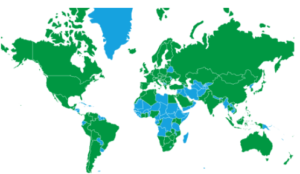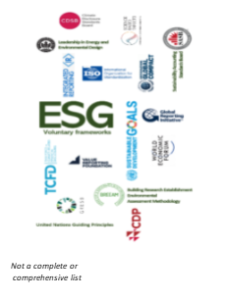ESG Landscape Primer

Stakeholder environmental, social and governance (ESG) disclosure pressures, expectations and requirements have rapidly increased over the last two decades. According to Carrot & Sticks’ interactive map, instruments exist in more than 80 countries.

In addition to the number of global reporting framework options, a lack of disclosure standardization creates challenges for producing ESG disclosures that satisfy a multitude of stakeholder needs. Despite reporting challenges, in November of 2021, an accounting of the most recently finished ESG reporting season by the Governance & Accountability Institute, Inc noted that 92% of S&P 500® and 70% of Russell 1000® Companies published voluntary ESG/sustainability reports.

While the prevailing means of reporting ESG information utilizes voluntary frameworks, the last two years have clearly signaled a trend to define and expand ESG regulatory metrics and standards in financial reporting.
In Europe, legislation focused on further standardization of ESG reporting for public companies came in the form of the EU’s 2021 Corporate Sustainability Reporting Directive (CSRD). Updating and replacing the Non-Financial Reporting Directive (NFRD), the CSRD is estimated to affect the required reporting of 50,000+ European companies. This change seeks to help stakeholders understand not only how the company impacts the environment and society, but also how the environment and society impact the company.
Additionally, in 2021, the International Financial Reporting Standards (IFRS) Foundation announced the creation of the International Sustainability Standards Board (ISSB). The focus of the ISSB is to provide high-quality, transparent, reliable, comparable and auditable ESG disclosures that allow investors to understand how ESG impacts enterprise value.
The new ISSB standard incorporates and builds on work by existing standards, including:

While it is too early to understand how the two EU standards will comprehensively work together, both bodies have expressed a desire for cooperation to better inform all stakeholders.
Moving the regulatory needle in the US, in March of 2022, the SEC proposed two new ESG rules. The first requires additional environmental disclosures related to climate change and greenhouse gas emissions; the second requires more information related to cybersecurity risk governance. The proposed climate rule also moves away from allowing companies to make disclosures based on what a reasonable investor would deem material to a prescriptive model that requires qualitative and quantitative disclosures in audited financial statements if climate risks impact reporting by 1% or more.
The latest proposed rules add to a string of regulations focused on corporate disclosures across the ESG spectrum. Previously adopted changes include a November 2020 requirement for companies to disclose more information related to human capital resources and a 2021 rule requiring that most Nasdaq-listed companies disclose more information related to board diversity.
Further, in alignment with global moves, in June of 2022, the International Auditing and Assurance Standards Board (IAASB) also signaled support for ISSB efforts by noting that assurance should play a crucial role in enabling and providing reliable, high-quality ESG reporting that investors and regulators can trust.
The newly proposed and recently adopted SEC rule changes focused on ESG are also responsible for increasing the number and quality of disclosures in regulatory filings. A review of SEC filings from 2020 through 2022 by White & Case revealed that climate-related disclosures dominated the most recent round of 10-K and proxy filings. Beyond climate, the largest area of disclosures focused on the environment, with topics such as recycling and renewable energy use. The review also found a significant increase in the disclosure of quantitative goals and targets in both environmental and social areas. Overall, seven dominant ESG focus areas were revealed:
- Environmental
- Human Capital Management
- Environment and social targets and goals
- Corporate culture
- Board oversight of environmental and social Issues
- Social impact/community
- Environment and social issues in shareholder engagements
To help ensure corporate reporting and disclosure success, regulators should consider an approach that eases companies into increased reporting demands. Gradual reporting changes by regulators would also allow companies to methodically build the capacity of internal ESG reporting teams to match demand.
Ultimately, successful reporting companies will be the ones that both invest in and understand how to report ESG information on par with financial reporting. Over the longer-term, to meet the demands of stakeholders and regulators alike, ESG literate financial service providers and ESG professionals will need to work side by side to provide the additional rigor and value currently missing in ESG reporting.
Want to learn about Frazier & Deeter’s ESG services? Visit our website here or contact us directly using the Contact Us feature.
Explore related insights
-
Leveraging State Tax Opportunities to Drive Business Growth
Read more: Leveraging State Tax Opportunities to Drive Business Growth
-
The IRS and Your Tax Return: What’s Changing This Year?
Read more: The IRS and Your Tax Return: What’s Changing This Year?






